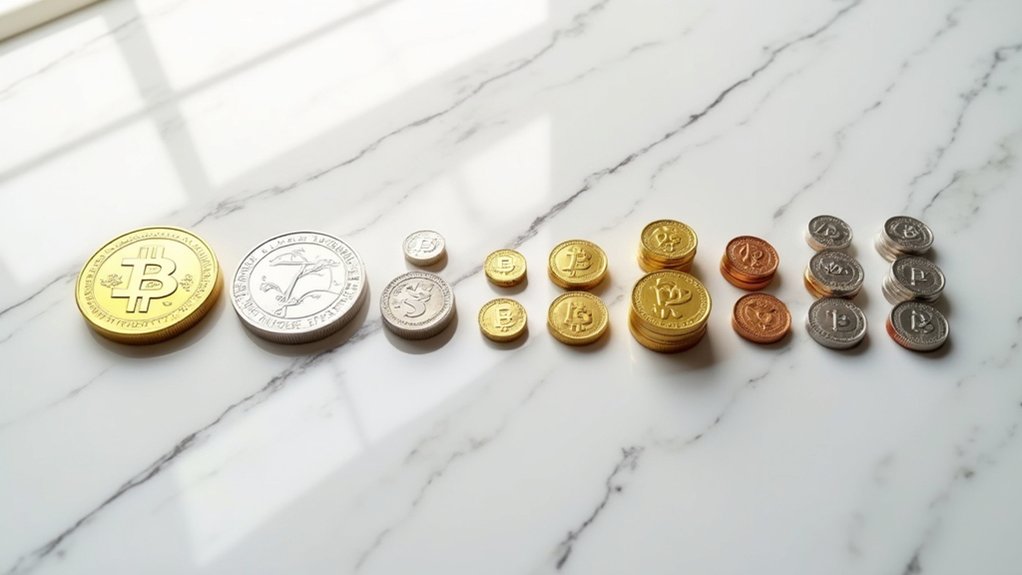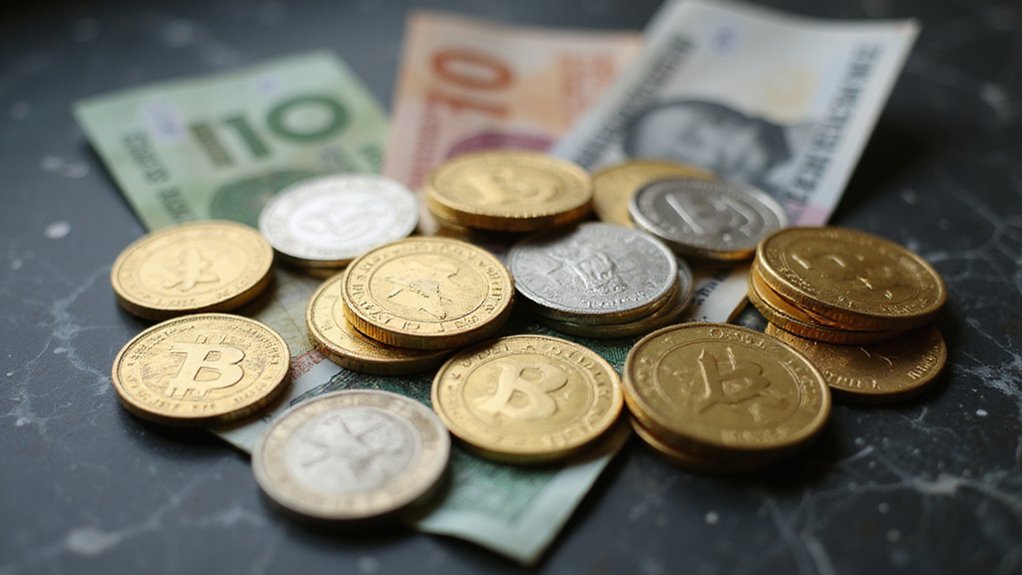The stablecoin universe of 2024 featured over 200 distinct tokens, though market reality proved decidedly less democratic than this numerical diversity suggests. USDT commanded nearly 80% of trading volume while USDC, DAI, and FDUSD carved out meaningful niches among institutional players. Yield-bearing variants captured 3% market share with 414% growth, and emerging networks like Base and Solana disrupted Ethereum’s dominance—though the deeper mechanics reveal fascinating complexities.

While traditional payment giants Visa and Mastercard have long dominated the narrative of global financial infrastructure, 2024 witnessed stablecoins quietly—and perhaps not so quietly—surpass their combined transaction volumes by 7.68%, processing an extraordinary $27.6 trillion in transfers throughout the year.
The stablecoin ecosystem expanded with remarkable velocity, achieving supply growth exceeding 59% and reaching approximately 1% of the entire U.S. dollar supply—a milestone that would have seemed fantastical mere years ago. Active wallet counts surged 53%, climbing from 19.6 million in February 2024 to over 30 million by February 2025, suggesting mainstream adoption accelerated beyond speculative enthusiasm.
USDT (Tether) maintained its iron grip on the market, commanding 79.7% of trading volume throughout 2024, while USDC and the rapidly ascending FDUSD demonstrated significant market capitalization surges. BUSD, conversely, experienced what industry observers might diplomatically term a “strategic retreat” from market prominence. USDT’s remarkable trajectory saw its market cap nearly double from approximately $39 billion in August 2023 to about $77 billion by December 2024.
USDT’s commanding dominance persisted while emerging players carved territory and established giants executed graceful exits from the stablecoin battlefield.
The emergence of yield-bearing stablecoins proved particularly remarkable, capturing over 3% of the market with a staggering 414% growth surge.
Perhaps most intriguingly, bot activity dominated the landscape, accounting for 70% of total transaction volume—with Solana and Base networks witnessing an almost surreal 98% bot-driven transaction share. This raises fascinating questions about the nature of “usage” in decentralized finance: are algorithms the primary beneficiaries of this monetary innovation? These stablecoins represent a fundamental shift toward peer-to-peer transactions that operate without traditional banking intermediaries, aligning with the broader DeFi movement.
The blockchain distribution landscape witnessed notable shifts, with Ethereum and Tron‘s combined dominance declining from 90% to 83% as emerging networks like Base, Solana, Arbitrum, and Aptos captured market share. This diversification reflects broader ecosystem maturation and the pursuit of optimization across different use cases.
Institutional adoption patterns emerged distinctly from retail behavior, with large transactions in FDUSD and DAI indicating sophisticated market participants’ growing comfort with stablecoin infrastructure. Meanwhile, USDT and USDC retained their positions as retail favorites, serving dual functions as transactional currencies and safe havens during market volatility. The total market size reached $227 billion as of March 11, 2025, demonstrating the ecosystem’s continued expansion beyond previous expectations.
Despite absolute growth metrics, stablecoins paradoxically lost 13.5% weight within the total cryptocurrency market capitalization—a reminder that even success operates within relative contexts in rapidly evolving digital asset markets.
Frequently Asked Questions
How Do Stablecoins Maintain Their Peg During Extreme Market Volatility?
Stablecoins employ multiple mechanisms during extreme volatility, though success varies considerably.
Asset-backed variants rely on robust reserves and rapid redemption processes, while algorithmic versions depend on smart contract responsiveness—assuming market participants maintain faith in the underlying mechanics.
Arbitrage opportunities theoretically restore equilibrium, yet extreme conditions can overwhelm these corrective forces.
Governance protocols implement circuit breakers and emergency measures, though one might question whether such interventions truly constitute “stable” behavior during market stress.
What Are the Regulatory Requirements for Launching a New Stablecoin?
Under the GENIUS Act of 2025, launching stablecoins requires traversing a regulatory gauntlet that would make traditional banking seem invigoratingly straightforward.
Issuers must secure federal or state licensing, maintain adequate capital reserves backing circulating tokens, and implement robust liquidity management systems.
AML/BSA compliance is mandatory, alongside periodic reporting of reserve holdings and risk exposures.
The framework applies to both banks and nonbanks, though capital requirements may vary—because regulatory consistency remains charmingly elusive.
Can Stablecoins Be Used for Cross-Border Payments Without Banking Intermediaries?
Stablecoins can indeed facilitate cross-border payments without traditional banking intermediaries, operating through blockchain networks that bypass correspondent banks entirely.
Users need only internet access and digital wallets—no bank accounts required. This peer-to-peer infrastructure enables 24/7 settlements while eliminating intermediary fees and processing delays.
However, complete banking avoidance remains somewhat theoretical, as most users still require fiat on-ramps through traditional financial institutions for initial stablecoin acquisition.
What Happens to Stablecoin Holders if the Issuing Company Goes Bankrupt?
When stablecoin issuers file bankruptcy, holders face a precarious hierarchy—ranking above general creditors but below secured lenders and DIP financiers under the GENIUS Act of 2025.
Retail holders without explicit redemption rights must often sell claims to institutions at steep discounts, while trustee funding gaps threaten prolonged proceedings.
The bitter irony? By the time bankruptcy begins, the peg has likely collapsed, leaving holders nursing losses before recovery even starts.
How Do Stablecoin Transaction Fees Compare to Traditional Payment Methods?
Stablecoin transaction fees dramatically outperform traditional payment methods in emerging markets, where remittance costs can reach 14% while stablecoins cost under a cent.
However, developed markets present a different calculus—Ethereum gas fees fluctuate wildly ($0.02-$3.33), and off-ramping costs (0.1%-7%) sometimes exceed traditional FX spreads.
The irony? While enterprises save $10,000-$30,000 on million-dollar transfers, small transactions face minimum redemption thresholds that would make traditional bankers blush.









